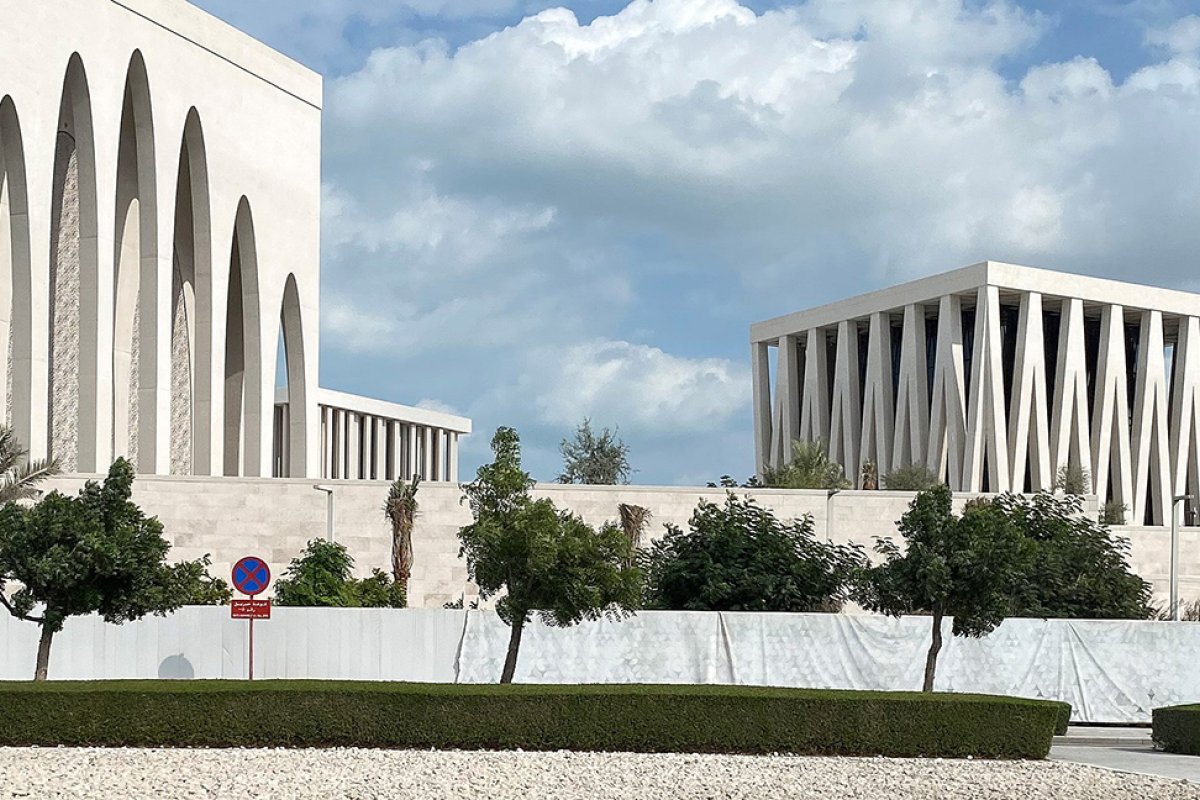
Tolerance as Tourism? Dual Developments in the Arab Gulf
Through the Abrahamic Family House, the UAE carefully curates the public sightseeing of what counts as true religion, what is tolerable and what is not, and what never reaches open discussion in the first place.
On March 1, the Abrahamic Family House opened to public visitors with much celebratory acclaim on Saadiyat Island in Abu Dhabi, the capital of the United Arab Emirates (UAE). The first of its kind, the Abrahamic Family House is the only site in the world where a synagogue, church, and mosque reside together as a multi-faith center of worship (for a similar site near completion, see Berlin’s House of One). Identical in their sleek size and complementary in their opulent white-marble design, the three houses of worship—the St. Francis of Assisi Church, the Moses Ben Maimon Synagogue, and the Imam al-Tayyeb Mosque—conjointly profess the UAE’s commitments to tolerance, dialogue, and the harmonious kinship of “the Abrahamic religions.”
Institutions of interfaith tolerance are not new in the Arab world. When I was doing fieldwork in Egypt during the Tahrir uprisings in 2011, for example, the Grand Imam Shaykh al-Tayyeb and the Coptic Orthodox Pope Shenouda III were beginning to establish the Egyptian Family House with the stated goal of decreasing sectarian tensions for the sake of national unity under a new Interim Cabinet. As in Lebanon, Turkey, and many other countries in the Middle East and North Africa, the civic and moral project of building tolerance mainly centers on nationals: the local religious communities whose appeal to a common national citizenry is their key resource for peaceful coexistence in times of turmoil, revolutionary change, or political uncertainty.
The Abrahamic Family House, by contrast, is a decidedly international and foreigner-focused adventure. Its opening follows from the UAE’s highly publicized declaration of 2019 as “The Year of Tolerance.” Far from being a mere marketing gimmick, The Year of Tolerance culminated in two pivotal events which were crucial for the Abrahamic Family House: 1) the signing of the Document on Human Fraternity by the Catholic Pope Francis and the Grand Imam Shaykh al-Tayyeb in 2019, and; 2) the signing of the Abraham Accords Peace Agreement at the White House by the UAE and Israel in 2020. Whatever the Abrahamic Family House stands for, its development hinged on interfaith memoranda from the Vatican and al-Azhar and the normalization of UAE-Israel relations. Although the director behind these theaters of peace and tolerance is from the UAE, most members of the Higher Committee of Human Fraternity—the executive branch of the Abrahamic Family House—are religious leaders hailing from foreign countries.
The Abrahamic Family House, then, originates not as a civic pedagogy of cultivating tolerance among Emirati nationals or even among the foreign migrant force of myriad faiths who make up a staggering 90% of the resident population hosted by the oil-rich monarchy. What does “tolerance” in the UAE, then, mean and look like, if its core authors are foreign bodies outside the UAE? Who are The Year of Tolerance and the UAE’s Ministry of Tolerance intended for?
In the UAE, tolerance promotion goes hand in hand with state-driven tourism development and investment. No visitor to the Abrahamic Family House today can possibly ignore the extravagant, mega-construction boom around it within the last decade alone. Saadiyat Island, or “Happiness” Island, is one of the UAE’s epicenters of cultural tourism, attracting foreign visitors to the numerous museums that have been or are being thrown up at a lightning pace to the tune of 100 million USD: the Zayed National Museum, the Louvre Abu Dhabi, the Guggenheim Abu Dhabi, the Natural History Museum Abu Dhabi, and still more to appear. Strategically located, the Abrahamic Family House is only one stop in a one-day travel itinerary to the Island, and only minutes away from high-rise condos and luxury resorts perched along the dazzling blue waterfront.
These dual developments of tolerance and tourism set the stage for Abrahamic Family House’s trailblazing value. Included in the visitor’s package is a ticket to experiencing world-making history at the exhilarating edge of development. A tour through the Abrahamic Family House is a journey to world record-setting breakthroughs that made it possible: the first papal visit to the Gulf, the first purpose-built synagogue in the Arab world, a landmark interfaith complex that is, indeed, “the first of its kind.”
Furthering the feel of the frontier, the Ministry of Tolerance declares the UAE is the “incubator” of tolerance, peace, and security. A term of art in the world of start-ups and cutting-edge innovation, “incubator” is more than suggestive. It invites a diverse portfolio of lucrative investments, including ventures into a bright future between faiths and bets on the alluring multi-billion dollar returns of normalization at a time when Israelis are confronting the most ultranationalist, far-right government in their history.
Profits and realpolitik aside, the Abrahamic Family House certainly fosters good intentions and cautious optimism. To welcome a steady stream of globetrotting guests and foreign investment, the UAE’s message to the whole world is clear: “moderation over fanaticism and extremism.” Why not jump on this rare opportunity to launch dialogues and experiment with unprecedented possibilities? Without a doubt, many of the Abrahamic Family House’s architects sincerely believe that tourism is compatible with tolerance, or at least, that tourism paves the path for the first steps to tolerance. Tourism, in their view, serves as an instrument or conduit for advancing peace and religious coexistence in a region where free trade agreements are the most expedient means for opening borders and bridging nations formerly at war.
And yet, tourism is far from a neutral medium for brokering dialogue based on shared “human values.” Tourism also changes the landscape of religion and inter-faith differences. To exhibit what is similar and shared, it privileges certain traditions and features of religious identity, setting others aside on the back burner or dismissing them altogether. By extension, tolerance as tourism changes what it means and looks like to tolerate other faiths and peoples of other backgrounds in a certain political environment. Through the Abrahamic Family House, the UAE carefully curates the public sightseeing of what counts as true religion, what is tolerable and what is not, and what never reaches open discussion in the first place.
Observers of the UAE, as well as residents of Abu Dhabi, have already voiced these dilemmas and risks at varying volumes. First, tolerance as tourism generates global hierarchies of racialized leisure and labor that often fly in the face of human rights. It is no secret that Saadiyat Island’s many tourist attractions, including the Abrahamic Family House, have been built on the backs of exploited migrant laborers. Second, tolerance as tourism sanctifies certain interfaith relations and geopolitical alliances over others. For the Abrahamic Family House, “the Abrahamic religions” is the referential horizon that signals the UAE’s tacit endorsement of certain authorities of the monotheistic faith traditions over marginal others (for example, the Shia minority in Dubai). These choices inevitably beg the question of which religious communities in the UAE, Emirati and non-Emirati, are the ones who suffer discrimination and harassment on an everyday basis, and what interfaith tourism does or does not do for their status as kin believers.
This problem of interfaith inclusion presents yet another political risk. When Pope Francis and the Shaykh al-Tayyeb first convened in 2019, rumors and allegations of a “new religion” surfaced from various corners online. Christians and Muslims accused the Higher Committee of Human Fraternity of inventing a syncretic amalgam of world faiths: “The Abrahamic Religion”, “Chrislam”, a “one world religion.” In our age of fake news and conspiracy theory, these rumors reveal what can happen when tolerance initiatives develop under the aegis of a deeply authoritarian state. For populists and anti-globalists, that tolerance is wrapped up with greater tourism revenue only confirms their suspicions that interfaith is a cover for increased political repression and economic coercion.
Tolerance as tourism therefore creates and does something in the world of religious differences. Instead of merely organizing and managing pre-given lines of faith, tolerance as tourism sets into play a whole panoply of new moral dilemmas and new political risks. Only time will tell what the Abrahamic Family House will achieve under such massive transformations in faith and regional security in the Arab Gulf.
This post was made possible by Nathalie Peutz’s generous invitation to New York University Abu Dhabi in February and March of 2023. Additional thanks go to Justin Stearns and Russell Johnson for their valuable feedback.
Image by Boubloub via Creative Commons.


